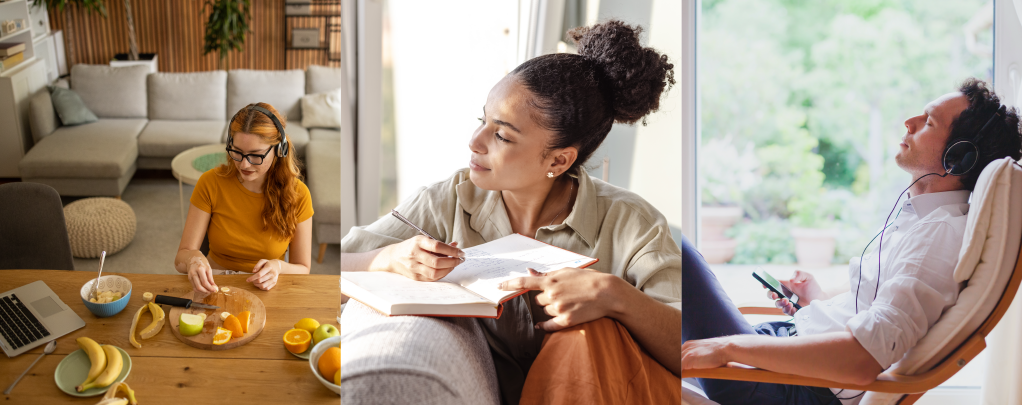B2B and the Bard: Powerful tech marketing insights from Shakespeare
January 5, 2024
By Dave Jagodowski
April 19, 2024

 Stress can come from anywere. But if you work in B2B marketing, you’re familiar with a particular kind: product launches, marketing campaigns, event planning and execution, back-to-back meetings, last-minute changes, and the like. According to Britannica.com, the chemical changes induced by stress are initiated by stimulation of the sympathetic nervous system.
Stress can come from anywere. But if you work in B2B marketing, you’re familiar with a particular kind: product launches, marketing campaigns, event planning and execution, back-to-back meetings, last-minute changes, and the like. According to Britannica.com, the chemical changes induced by stress are initiated by stimulation of the sympathetic nervous system.
This “fight-or-flight” system controls involuntary body functions and springs into action during physical or emotional duress. You can’t control it any more than you can control your leg when the doctor hits your kneecap with that triangular hammer thingy.
Once triggered, the stress response results in the emission of chemicals, such as adrenaline, epinephrine, and cortisol, that increase your heart rate, blood pressure, and glucose levels to get your body ready for action. This could be an urgent physical response, such as jumping out of the way of an oncoming car, or a mental threat, such as receiving a tax audit notice.
In this way, stress serves as a self-preservation mechanism. So why is it killing so many of us via high blood pressure, heart disease, unhealthy weight gain/loss, depression, sleeplessness, and more?
It comes down to coping. (And if you're not coping, you can skip ahead to the techniques.)
Stress can be associated with positive things as well as negative things. Buying a home, starting a job, moving to a new place, and having a child are all positive changes that come with stress. Being stressed doesn’t necessarily mean things are bad in your life—it could mean you’re overwhelmed or in transition.
Stress can be a great motivator. When faced with a challenging deadline, we can feed on that stress energy to kick ourselves into turbo mode and get things done rapidly. Some people say that they thrive on stress, so stress is often a necessary ingredient to achievement.
The part of stress we really don’t like are the repercussions:
 Even though all humans share the same basic physiology, we experience stress very differently. Not all relaxation techniques work for everyone. The key lies in finding what resonates with your mind and body.
Even though all humans share the same basic physiology, we experience stress very differently. Not all relaxation techniques work for everyone. The key lies in finding what resonates with your mind and body.
For me, a change of scenery often gets the job done. I call it “going to my happy place.” Mine is a local restaurant/bar, but it could be a favorite coffee shop or even a store or a park that provides sufficient distraction and gives you a chance to disconnect from your stressful environment and mentally regroup.
In B2B marketing, things not only move fast, they also change fast, turning your best-laid plans into potential stressors. These 11 techniques can be done in your home office, your cubicle, or even your car. Explore which ones work best for you, and share them with your overstressed colleagues.
If you work exclusively from home, you’ll be able to do all these with no special equipment. However, since many of us are hybrid workers, the first six techniques can be done in your cubicle or office without drawing unwanted attention to yourself.
Deep, slow, mindful breathing can help reduce stress. It shifts the body's automatic response from “fight or flight” to relaxation. Here’s a link to a simple starting technique called “box breathing.”
The goal of PMR is to induce deep relaxation by consciously tensing and then relaxing your muscles. It makes you more aware of physical sensations so you recognize and counteract the physical signs of stress and anxiety. (This one surprised me!)
Mindfulness involves focusing on the present moment without judgment. This can be done through guided meditations or, on your own, focusing on your breath, an object, or even a word or phrase.
Writing down thoughts and feelings can release emotions and stress. Journaling should be done with paper and pen (not a keyboard) as there is something inherently personal about handwriting that will help you connect to your deeper thoughts and feelings.
Engaging in creative activities like painting, drawing, or crafting can help distract the mind from stress and provide a sense of calm. I found this one more challenging simply because I don’t have an artistic bone in my body. But if you do, give it a try.
Listening to calming music can lower blood pressure, heart rate, and anxiety levels. I happened upon a young artist from England named Lucy Thomas who has a pristine voice that turns me into a puddle. Put on your headphones and start with her cover of Leonard Cohen’s “Hallelujah” and let the tingles begin.
While you could do this at the office, it might be hard to relax when people keep interrupting to ask you if you’re okay. I really enjoyed this 20-minute in-chair routine that combines effective stretching exercises with deep breathing and mental focus.
When you can’t get to your happy place, you can still use the power of your imagination. Guided imagery involves visualizing a peaceful place or situation. The guidance can be provided by a video, through an app, and, eventually, just on your own.
When we’re stressed, we tend to eat fast and make unhealthy decisions. Certain foods and snacks can decrease cortisol in your system and reduce your stress response, particularly those high in B vitamins, omega-3s, magnesium, and protein. Eating right can be a proactive way to combat stress.
Spiritual practices, such as prayer, meditation, and attending religious services, provide a sense of purpose and connection and encourage empathy and kindness, which fosters positive relationships and a supportive community. Here’s a soothing (non-denominational) way to get started.
Laughter really is the best medicine. It stimulates the heart, lungs, and muscles and increases endorphins. While there’s nothing like the real thing, there is growing evidence that even faking laughter for 30 seconds yields many of the health benefits. Here’s a one-minute exercise to get you started.

The stress-reduction techniques above are no substitute for doing the big things—a healthy work/life balance, a smart diet, modest exercise, and a good night’s rest. But at the very least, these techniques let you take a little time for yourself and unplug from the world for a bit. Even just stepping away from your desk one or two times a day to take a 10-minute walk can do wonders for your mindset.
We all live in this giant stress ball of a world, and working in the fast-paced B2B marketing industry doesn’t afford us many opportunities to stop and smell the roses. As you work out your own relaxation techniques, don’t forget to look out for your coworkers. Sudden changes in mood or work performance can be a sign of emotional distress. Taking the time the check in will make them feel appreciated, and that’s something all humans need.
This month, and every month going forward, make the time to find your happy place. Connect to something greater than yourself and your job, and start living your best life!
We take pride in a team loaded with smarts, wit, and ideas. If you'd like to have a smarter, wittier inbox filled with ideas each month, subscribe here to the MarketReach Blog, and we will let you know when there is something new you might like!

Need us now? Just want to learn more? We’d love to talk.